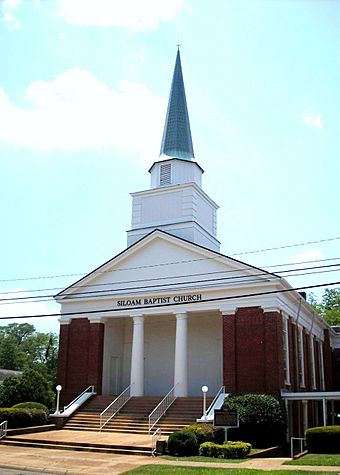Siloam Baptist Church facts for kids
Quick facts for kids |
|
|
Siloam Baptist Church
|
|

Siloam Baptist in July 2009
|
|
| Location | 503 Washington St., Marion, Alabama |
|---|---|
| Area | 0.7 acres (0.28 ha) |
| Built | 1848 |
| Architectural style | Greek Revival |
| NRHP reference No. | 82001615 |
| Added to NRHP | December 27, 1982 |
The Siloam Baptist Church is a historic church in Marion, Alabama. Its church community started in 1822. The beautiful brick building you see today was finished in 1848.
Many people consider Siloam Baptist Church to be a very important "mother church" for many other Baptist churches and schools in Alabama. This means it helped start them. Members from this church were key in setting up Judson College in 1838 and Howard College (now called Samford University) in 1841.
Contents
Siloam Baptist Church History
Starting the Church in Marion
Siloam Baptist Church began in June 1822. This was around the same time the city of Marion was founded. The main person who helped start the church was a preacher named Charles Crow.
The first church building was made of logs. Later, in 1837, a more detailed wooden church was built. Both of these early buildings were located near what is now the Marion Cemetery.
A Place for New Colleges
In 1838, people from Siloam Church helped create Judson College. Then, in 1842, Howard College was also started in Marion by Baptists. Howard College is now Samford University, located in Birmingham.
In 1844, a very important meeting happened here. The Baptist State Convention adopted the "Alabama Resolutions." This led to the separation of Baptist churches in the Southern United States from those in the North in 1845. This was the beginning of the Southern Baptist Convention. The first meeting for the Home Mission Board of the Southern Baptist Convention also took place here in 1845. The table used for that meeting is still in the church's Memorial Parlor.
Building the Current Church
In November 1847, Siloam Church bought the land where the current building stands. L. Y. Tarrant was the architect and builder of this new church. Many workers who were enslaved helped build it. The bricks used were made from local clay.
The new church building was very large for its time. It was dedicated and opened for use in 1849. When it was finished, Siloam was one of the biggest churches west of Augusta, Georgia. It was seen as a very important church in the Southwest. Marion became a center for mission work throughout Alabama and the South. The Alabama State Convention met here every other year from 1848 to 1868.
Inside the Sanctuary
The main worship area, called the sanctuary, was simply decorated. It was lit by oil lamps hanging from the ceiling and on the walls. The windows had three large sections with clear glass. These heavy window sections could be opened from the top or bottom using pulleys and cords.
An old record says that the church had a gallery, which was like a balcony, on three sides of the sanctuary. This area was used by people who were enslaved, and they entered it from outside stairs. After the Civil War, when slavery ended, Siloam Church helped start the Berean Baptist Church. The steeple on Berean Church looks just like the original steeple on Siloam, which was replaced in 1949 after a fire.
Changes Over Time
The newspaper "The Alabama Baptist" was first printed in Marion in 1849. It continued to be published there from 1849 to 1852, and again from 1874 to 1877.
In 1894, some big changes happened inside Siloam Church. The old galleries were removed, and a new balcony was built. Beautiful stained glass windows were put in place. A pipe organ was also installed, which was first operated by hand. In 1922, the organ was updated to use an electric motor.
In 1926, an educational building was added behind the main church sanctuary.
A major update happened in 1955. The walls and ceilings of the historic sanctuary were repaired and painted. A new lighting system and air conditioning were installed. New carpets were laid, and the church pews (benches) were refinished. The old pipe organ was replaced with a new electronic organ.
The Memorial Parlor was created in 1958. This special room was designed to hold historical items from Siloam Church.
In 1959, the church decided to build another educational wing. This new section was for students from Judson College and Marion Institute, as well as younger children. The Alabama Baptist State Convention and Siloam Baptist Church worked together to build this new unit.
A new Wicks organ was installed in 1974.
In 1982, Siloam Baptist Church was recognized as a very important historical site. It was added to the National Register of Historic Places by the United States Department of the Interior.
The last major updates to the sanctuary happened in the summer of 1997. A new sound system was put in, and the floors were strengthened and refinished. The pews were refinished, and new cushions and carpet were installed. A new roof was put on, and the walls were painted.
In 2007, a long-held dream came true for many church members: an elevator was installed. This elevator makes it easier for everyone to access the sanctuary and all floors of the educational building built in 1959.



